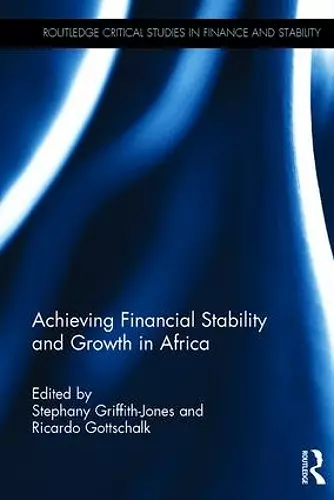Achieving Financial Stability and Growth in Africa
Stephany Griffith-Jones editor Ricardo Gottschalk editor
Format:Hardback
Publisher:Taylor & Francis Ltd
Published:24th Mar '16
Currently unavailable, and unfortunately no date known when it will be back
This hardback is available in another edition too:
- Paperback£26.99(9780367875657)

This book explores how the financial system should be regulated and structured to achieve the twin goals of inclusive growth and financial stability, with a focus on African low-income countries (LICs). The subject and content of this book is original in that it attempts to draw on the lessons and radical rethinking on the financial sector in developed and middle income countries, arising in the wake of the international financial crisis. It includes four in- depth country case studies, of Kenya, Ghana, Nigeria and Ethiopia, but also analyses the empirical evidence for Sub-Saharan Africa as a whole, evaluating the relevance (or not) of such major changes for the very different financial sectors and economies in low income countries.
Achieving Financial Stability and Growth in Africa has major academic and policy implications, especially for low income countries, but also more generally, on broader issues. These include the desirable size of the financial sector, as well as more specific issues, such as the high cost of borrowing of small and medium enterprises in LICs, and possible measures to reduce it. Highly topical subjects like the appropriate regulation of the financial sector and management of capital flows are discussed in depth. Though drawing on comprehensive reviews of the literature, this volume has the virtue of the large comparative academic and policy experience of researchers, as well as in-depth case studies, that take account of institutional and economic features of low- income countries.
Written by senior academics and policy-makers, this book is a must read for those researching or participating in the financial sectors of low-income countries, as well as in developed economies. It is also suitable for those who study political economy and public finance.
'Packs a lot in 186 pages, is essential reading for specialists, and an excellent source of reference that should be on every central bank library shelf." — John Chown, Central Banking Journal
‘Ahead of the 2008 crisis many economists assumed that financial deepening – including increased private credit as a percent of GDP – was always positive for economic growth. We now know that there can be too much finance and too much private credit. But good finance is still crucial to economic development, and low- income countries must use the lessons of the global financial crisis to help identify which forms of financial development are most beneficial. This book will play an important role in that debate, combining sound empirical analysis, informative case studies and thoughtful synthesis of the overall insights and implications.’ — Adair Turner, former chair of the UK Financial Services Authority and author of Between Debt and the Devil
‘This is a compelling factual study about a critical dilemma for policy making in LICs – delicately balancing the trinity of financial inclusion, financial stability and growth agendas. This is even more challenging in the face of globalisation, inadequacies within domestic jurisdictions, ongoing reforms to global regulatory architecture and new rules like Anti Money Laundering that pose unintended consequences.’ — Louis Kasekende PhD, Deputy Governor, Bank of Uganda
‘This book is very timely - we know that for many low income countries financial regulation is at a crossroads, as policy makers strive to find a promising way forward, after the global financial crisis (2007-8). Of course, some recent studies have tried to re-examine financial regulation post-2008. But this book is exceptional: it offers a nice twist, ‘financial regulation for stability and growth’; it is meticulously researched, under an ESRC-DFID funded project on bank regulation, led by Stephany Griffith-Jones and involving other leading scholars in the field, who have deep appreciation for policy and practice. Moreover, the book presents a uniquely rich body of findings from four case studies, on Ghana, Ethiopia, Nigeria and Kenya, written by country scholars (e.g. the case on Kenya by Francis Mwega is a prize winner). The case study findings will ring bells with researchers and resonate with policy advisers and policy makers at central banks in Africa. Overall, I strongly endorse this outstanding book, which will strike a chord with many African central bank governors, on the question of financial regulation for stability!’ — Professor Victor Murinde, University of Birmingham, UK
"This interesting book has both superb qualities and surprising omissions, discussing an important and highly topical subject. (…) [It] offers a comprehensive review of previous academic literature, and is based on a three-year international project. (…) [It] is essential reading for specialists and an excellent source of reference that should be on every central bank library shelf."– John Clown
ISBN: 9781138123731
Dimensions: unknown
Weight: 530g
186 pages